A compendium and comparative epigenomics analysis of cis-regulatory elements in the pig genome
- PMID: 33850120
- PMCID: PMC8044108
- DOI: 10.1038/s41467-021-22448-x
A compendium and comparative epigenomics analysis of cis-regulatory elements in the pig genome
Abstract
Although major advances in genomics have initiated an exciting new era of research, a lack of information regarding cis-regulatory elements has limited the genetic improvement or manipulation of pigs as a meat source and biomedical model. Here, we systematically characterize cis-regulatory elements and their functions in 12 diverse tissues from four pig breeds by adopting similar strategies as the ENCODE and Roadmap Epigenomics projects, which include RNA-seq, ATAC-seq, and ChIP-seq. In total, we generate 199 datasets and identify more than 220,000 cis-regulatory elements in the pig genome. Surprisingly, we find higher conservation of cis-regulatory elements between human and pig genomes than those between human and mouse genomes. Furthermore, the differences of topologically associating domains between the pig and human genomes are associated with morphological evolution of the head and face. Beyond generating a major new benchmark resource for pig epigenetics, our study provides basic comparative epigenetic data relevant to using pigs as models in human biomedical research.
Conflict of interest statement
The authors declare no competing interests.
Figures
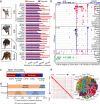
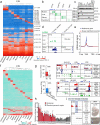
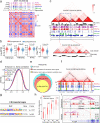
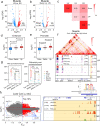
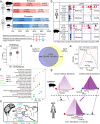
Similar articles
-
Epigenomics analysis of miRNA cis-regulatory elements in pig muscle and fat tissues.Genomics. 2022 Mar;114(2):110276. doi: 10.1016/j.ygeno.2022.110276. Epub 2022 Jan 31. Genomics. 2022. PMID: 35104610
-
A comparative analysis of chromatin accessibility in cattle, pig, and mouse tissues.BMC Genomics. 2020 Oct 7;21(1):698. doi: 10.1186/s12864-020-07078-9. BMC Genomics. 2020. PMID: 33028202 Free PMC article.
-
Identification and Conservation Analysis of Cis-Regulatory Elements in Pig Liver.Genes (Basel). 2019 May 7;10(5):348. doi: 10.3390/genes10050348. Genes (Basel). 2019. PMID: 31067820 Free PMC article.
-
Identifying co-opted transposable elements using comparative epigenomics.Dev Growth Differ. 2018 Jan;60(1):53-62. doi: 10.1111/dgd.12423. Epub 2018 Jan 24. Dev Growth Differ. 2018. PMID: 29363107 Review.
-
Prospects and challenges of epigenomics in crop improvement.Genes Genomics. 2022 Mar;44(3):251-257. doi: 10.1007/s13258-021-01187-9. Epub 2021 Nov 27. Genes Genomics. 2022. PMID: 34837632 Review.
Cited by
-
PorcineAI-Enhancer: Prediction of Pig Enhancer Sequences Using Convolutional Neural Networks.Animals (Basel). 2023 Sep 15;13(18):2935. doi: 10.3390/ani13182935. Animals (Basel). 2023. PMID: 37760334 Free PMC article.
-
Remnant of Unrelated Amniote Sex Chromosomal Linkage Sharing on the Same Chromosome in House Gecko Lizards, Providing a Better Understanding of the Ancestral Super-Sex Chromosome.Cells. 2021 Nov 1;10(11):2969. doi: 10.3390/cells10112969. Cells. 2021. PMID: 34831192 Free PMC article.
-
Haplotype-resolved 3D chromatin architecture of the hybrid pig.Genome Res. 2024 Mar 20;34(2):310-325. doi: 10.1101/gr.278101.123. Genome Res. 2024. PMID: 38479837 Free PMC article.
-
Expression patterns of housekeeping genes and tissue-specific genes in black goats across multiple tissues.Sci Rep. 2024 Sep 19;14(1):21896. doi: 10.1038/s41598-024-72844-8. Sci Rep. 2024. PMID: 39300207 Free PMC article.
-
Integration of ATAC-seq and RNA-seq analysis identifies key genes affecting intramuscular fat content in pigs.Front Nutr. 2022 Oct 5;9:1016956. doi: 10.3389/fnut.2022.1016956. eCollection 2022. Front Nutr. 2022. PMID: 36276837 Free PMC article.
References
Publication types
MeSH terms
Substances
LinkOut - more resources
Full Text Sources
Other Literature Sources
Molecular Biology Databases

